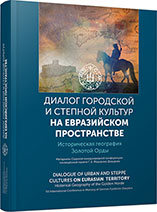К исторической топографии Нижнего и Верхнего Джулатов золотоордынского времени (историографические аспекты)
Historical topography of the Lower and Upper Djulat cities in the Golden Horde time (aspects of historiography)
Author(s): Sergey N. Savenko
Subject(s): History, Archaeology, Regional Geography, Historical Geography, Middle Ages, 13th to 14th Centuries, 15th Century
Published by: Издательский дом Stratum, Университет «Высшая антропологическая школа»
Keywords: North Caucasus; the Terek River; Golden Horde; cities; the Djulats; study history;historical topography;
Summary/Abstract: The report is devoted to consideration of the 5 stages (from the 18th century to the present) in the history of the study of Lower and Upper Djulat, the Golden Horde cities in the central part of the Northern Caucasus, located in the middle course of the Terek River, with a primary emphasis on their historic topography. The features of the source base accumulation, including archaeological materials, are discussed. At all stages, the researchers have commented on the extent, importance and chronological development peculiarities of the Djulat cities. The most extensive data on the historical topography is provided in the monographs by V.A. Kuznetsov (2003, 2014), E. D. Zilivinskaya and I. M. Chechenov (2015). Alongside with the specification of the settlements dimensions and structural elements, stratigraphy determination, characteristics clarification, and dating of the objects (mosques, temples, fortification elements, welfare facilities, burials, private burial vaults, etc.), there still remain unsolved problems related to the basis and historical circumstances of the emergence of major Golden Horde settlements on the Lower and Upper Djulats. The internal structure of these cities, the dynamics of their territorial expansion and development at various historical stages in the mid-13th — early 15th centuries require further research.
Book: Диалог городской и степной культур на Евразийском пространстве. Историческая география Золотой Орды
- Page Range: 246-252
- Page Count: 7
- Publication Year: 2016
- Language: Russian
- Content File-PDF

